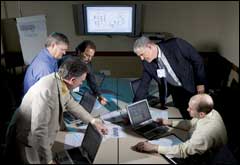For more than 25 years, U.S. News & World Report has ranked The Ohio State University Wexner Medical Center in Columbus among the top performers nationally for numerous adult procedures and specialties, including nephrology, cancer, and ear, nose, and throat. This versatility is reflected in the responsibilities of the clinical engineering department, too. Here, associate directors Anthony McCabe and Richard Eldridge discuss the scope of their work and how they go about keeping current with the needs of a vast and varied medical system.
24×7 Magazine: Can you please tell us a little bit about your department and the equipment you maintain?
Anthony McCabe: The Ohio State University Wexner Medical Center Department of Clinical Engineering is responsible for more than 40,000 unique medical devices. Located in Central Ohio, the department supports Ohio State University Hospital, Richard M. Ross Heart Hospital, East Hospital, Ohio State Harding Hospital, Dodd Rehabilitation Hospital, and the Ohio State Brain and Spine Hospital as well as The Ohio State University Comprehensive Cancer Center—Arthur G. James Cancer Hospital and Richard J. Solove Research Institute. Our staff of about 50 employees is also responsible for several ambulatory sites including surgery centers and physician offices.
24×7: What would your team say are the biggest challenges they face on a daily basis?
Richard Eldridge: One of the biggest challenges the clinical engineering department faces each day is maintaining a firm cybersecurity posture. Navigating medical device vulnerabilities is a new frontier from the traditional work of clinical engineering teams. We are challenged with balancing the research required to stay on top of threats and the costs associated with operating system and equipment upgrades. Benchmarking isn’t something easy to capture today on the value add to healthcare organizations of the additional workload of medical device cybersecurity. Every organization may be handling it a little bit differently with the same overall goal that’s always been there: safe and operational equipment for our patients.
24×7: Given the looming staffing crisis, what steps are your team taking to attract and maintain top talent?
McCabe: The clinical engineering department at the Ohio State Wexner Medical Center has a thriving internship program that recruits students from Ohio State University and neighboring colleges. The students gain valuable hands-on experience, and our leadership team has a pipeline for full-time staff.
To retain existing employees, we’ve created a career ladder for technical staff and perform regular market salary analyses to ensure our pay rates are competitive. Ohio State offers a tuition-assistance plan that allows us to make an educational investment in our staff, which is crucial to maintaining top talent. Ongoing education prevents complacency and allows our team to keep up with technology advancements.
Eldridge: We have a wonderful partnership with the faculty in the engineering department at Ohio State to participate in and develop several programs. I’ve presented to the Biomedical Engineering Society, we’ve given tours to the Ohio State Women in Engineering professional organization, I’m a mentor with Ohio State’s Diversity, Outreach and Inclusion Program in the College of Engineering, and I’ve given presentations in several junior- and senior-level biomedical engineering courses at Ohio State. There isn’t a specific collegiate degree program for clinical engineering, but establishing these partnerships has opened up new avenues of recruiting. We now have a means of telling the story of who we are and what we do. And even above and beyond that, it has allowed us to share, coach, and mentor the young, up-and-coming engineers. That is what is truly amazing and very fulfilling.
24×7: Can you please discuss a time when your team “saved the day” for another department?
McCabe: One of our values at The Ohio State University Wexner Medical Center is inclusiveness—working together for a common purpose across our various disciplines. We do it every day, but if I have to pick an example to highlight our teamwork, it would be the way our team sprang into action when a water line ruptured a few years ago in one of our hospitals, affecting a critical area for patient care. Our team acted quickly to help the department move equipment and supplies into storage areas. Then we worked with our facilities department and their contractors to get the area cleared and reassembled in a timely manner to mitigate the impact to our patients.
24×7: How is your department working with IT team members to keep devices secure and thwart cyberattacks?
McCabe: Our department worked with our peers in IT to form a committee to oversee medical device cybersecurity. This collaboration allows us to pull in other key members of our organization, like the supply chain department, to refine our processes on how equipment comes into our organization. It allows for gates in the process, so we can streamline technology acquisition while meeting cybersecurity needs.
For existing inventory, it’s been a fantastic experience having both The Ohio State University Wexner Medical Center IT and The Ohio State University IT departments working with us on newly defined vulnerabilities and how to remediate and defend against them using the National Institute of Standards and Technology framework.
Eldridge: We also have representation on a national medical device cybersecurity council to help champion the larger systemic issue of medical device cybersecurity among manufacturers. We added IT specialists to the clinical engineering team to help us navigate this journey. They serve as liaisons to the IT security and risk teams and work with our vendors to collaborate in a more effective manner.
24×7: What else should 24×7 Magazine readers know about your department?
Eldridge: Being part of a large academic health center allows our department to have unique opportunities to help educate and support the community. We are proud to support the Women in Engineering and the Diversity, Outreach and Inclusion programs at The Ohio State University College of Engineering. We are active supporters in the engineering community as mentors and presenters of not only what we do, but where we have been and how we have gotten here. We serve as chairs and are active members of group purchasing organization councils including cybersecurity. We also work with the local public school systems to raise awareness of careers in clinical engineering.
Our department gives back by assisting not-for-profit organizations such as LifeCare Alliance, which provides health and nutrition services to Central Ohio residents. We are also involved in our local healthcare technology management organization to help support our technical community and schools as well as partnering with The Ohio State University Veterinary Medical Center.





